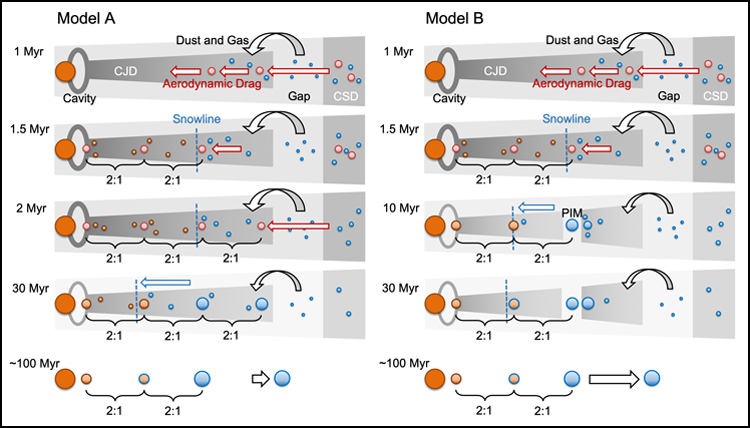Although they were identified over 400 years ago by Galileo Galilei, the formation of the four major moons of Jupiter has remained a mystery. Any successful model must explain all of the observed characteristics of the satellites, but most are able to explain only some. However, in a new model suggesting a slow formation over 10 million years, scientists claim to be able to explain many of the characteristics simultaneously.
“Our scenario is unique to simultaneously reproduce the disparate properties of the Galilean satellites—mass, orbits, composition, and internal structures.”
“In classical models, satellites accrete kilometer-sized bodies quickly. On the other hand, in our model, satellites accrete roughly 10-centimeter-sized particles slowly,” said Yuhito Shibaike, a researcher at the University of Bern in Switzerland and lead author of a new study on the technique. “Our scenario is unique to simultaneously reproduce the disparate properties of the Galilean satellites—mass, orbits, composition, and internal structures.”
Scientists agree that the Galilean moons formed out of the dusty disk left over after Jupiter’s formation. But the specifics, like how the initial moon seeds formed and how they reached their current orbits, are debated. The new model, detailed in a paper accepted to the Astrophysical Journal, applies a well-tested mechanism for planet formation, called pebble accretion, to satellite formation.
“After we started to work in this scenario, we realized the similarity between the Galilean system and TRAPPIST-1 system,” Shibaike said, referring to the nearby planetary system with seven known terrestrial planets. “The comparison of the two systems, and their formation scenarios, was helpful to develop our Galilean satellite formation scenario.”
Making Moons
The model proposes a slower formation period than many previous models. The seeds that would ultimately become the moons were first formed in the disk of gas left over from the Sun’s formation.
When Jupiter, coalescing out of the same disk of material, reached 40% of its current mass, the seeds were gravitationally captured by a disk of gas surrounding the infant planet. Over the next million or so years, the seeds quickly migrated closer to Jupiter, where they then slowly grew in size.
The innermost accreting infant satellite, which would grow up to become Io, was first stopped by a cavity in the disk. The cavity was created by Jupiter’s strong magnetic field, which removed material from the inner 420,000 kilometers surrounding the planet. By around 4.5 billion years ago, the migrations of the other moons also halted as they were captured at distances that resonated with the orbit of Io.
.

Delving into Differences
This slow accretion method is able to explain the differences in composition between the moons, which have different fractions of ice and rock in their interiors.
Io, which formed closest to Jupiter, is nearly all rock.
Europa began by accreting rock, but as the snowline (the distance at which water vapor and other volatiles condense) shrank around Jupiter, Europa’s nursery became cooler. By the end of the moon’s formation, it had accreted a small fraction of ice.
Ganymede and Callisto, which always remained beyond the snowline, are both about half rock, half ice.
Though Ganymede and Callisto are approximately the same size and were formed in similar environments, they ended up with different interiors. Ganymede has a fully differentiated interior with a hot, metallic core heated by the radioactive decay of an isotope of aluminum. Callisto’s interior is only partially differentiated and composed of rock and ice.
The new model explains the differences in the two moons through a delay in Callisto’s formation. Callisto is proposed to have started forming hundreds of thousands of years after Ganymede, when more of the aluminum isotope had already decayed away.
Although the model is able to explain many of the characteristics of the moons, there are some things it can’t yet explain, such as the orbit of Callisto, which currently doesn’t orbit in resonance with the other Galilean moons.
“Shibaike et al.’s study is definitely a good alternative to the previously proposed models. The fact that not many generations of satellites could have formed around Jupiter and that the migration of the moons should have been stopped seems robust. However…I believe that there is still a lot to understand on the formation of the Galilean satellites,” said Thomas Ronnet, a researcher at Lund Observatory in Sweden who was not involved with the new study.
—Mara Johnson-Groh ([email protected] ), Freelance Science Writer
Citation:
Johnson-Groh, M. (2019), Jupiter’s Galilean moons may have formed slowly, Eos, 100, https://doi.org/10.1029/2019EO134561. Published on 30 September 2019.
Text © 2019. The authors. CC BY-NC-ND 3.0
Except where otherwise noted, images are subject to copyright. Any reuse without express permission from the copyright owner is prohibited.

